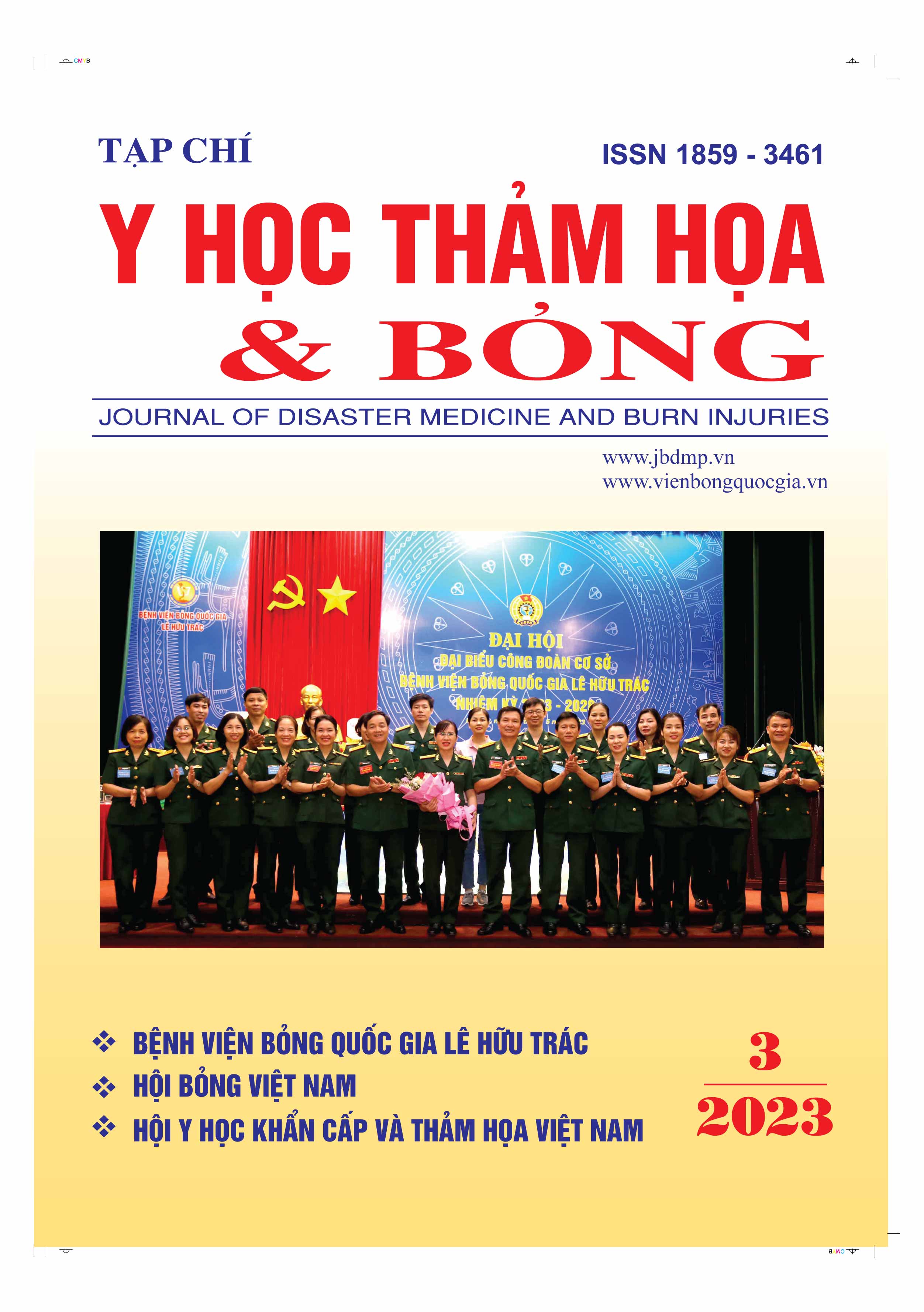Characteristics of collection, results of treatment of patients in 2 years to prevent Covid-19 presentation
Main Article Content
Abstract
Objectives: To evaluate some epidemiological characteristics and treatment results of burn patients treated at the National Park Service during 2 years of COVID-19 disease prevention (2020 - 2021).
Subjects and methods: Retrospective study on 10,050 burn patients who were treated at the National Burn Hospital from 2018 to 2021. Patients were divided into two groups before (2018 - 2019) and during the COVID-19 epidemic (2020 - 2021) for comparison.
Result: The number of patients entering treatment decreased (64.6% compared to the pre-epidemic period); the age group < 16 decreased by 37.7%, the population with health insurance increased by 87.1%; the rate of hospitalization in 24 hours after burns decreased sharply (54.1% compared with 87.4%, p < 0.001); did not increase much in June, August, August; patients with electrical burns increased in both number and percentage (657 accounted for 16.7% compared with 645 accounted for 10.6%, p < 0.05); burn area is 9 (3 - 18) vs 7 (3 - 15)% TBSA, p < 0.001, deep burn is 3 (1 - 8) vs 2 (1 - 7)% TBSA, p < 0.01.
During the period of COVID-19, the treatment day is 16 (10 - 29) days. The mortality rate was 3.3% (compared to 3.4% in the previous period, p > 0.05). The hospital day the patient died was 11 (2 - 24) days compared with 7 (2 - 14) days in the previous period, p < 0.01. LA50 is 74% TBSA (compared to 63% TBSA in the previous stage), and deep burns are 44% TBSA (compared to 35% TBSA in the previous stage). Respiratory damage has a mortality rate of 39.6% (compared to 57.5% in the previous period, p = 0.002).
Conclusion: During the COVID-19 epidemic period, the number of burn patients decreased, the rate of severe burns was higher. Although the mortality rate remained unchanged, the indicators pointing to a better quality of treatment may be due to many favorable conditions for treatment such as reduced patient density, and concentration of resources.
Article Details
Keywords
Epidemiology, treatment outcomes, burn patients, Covid-19 epidemic
References
2. Kruchevsky D., Arraf M., Levanon S., et al (2020). Trends in Burn Injuries in Northern Israel During the COVID-19 Lockdown. Journal of burn care & research.42 (2): 135-140.
3. Wikipedia (2023). Dòng thời gian của đại dịch COVID-19 tại Việt Nam, .
4. Farroha A., (2020). Effects of COVID-19 pandemic on burns epidemiology. Burns.46 (6): 1466.
5. D’Asta F., Choong J., Thomas C., et al (2020). Pediatric burns epidemiology during COVID-19 pandemic and ‘stay homecare. Burns.46 (6): 1471.
6. Da Rocha B. d. F. M., Bochnia M. F., Ioris R. A.. et al (2022). The impact of social isolation by COVID-19 on the epidemiological and clinical profiles of the burn patients. A retrospective study. Burns.48 (4): 976-983.
7. Kobarg B. S., Guanilo M. E. E., Bernard G. P.. et al (2023). National multicentric study on the incidence of alcohol burns during the COVID-19 pandemic. Burns.49 (3): 615-621.
8. Codner J. A., De Ayala R., Gayed R. M.. et al. (2021). The impact of the COVID-19 pandemic on burn admissions at a major metropolitan burn center. Journal of burn care & research.42 (6): 1103-1109.
9. Christ A., Staud C. J., Wielscher M.. et al (2023). Impact of the COVID-19 pandemic on the epidemiology of severe burns. Wiener Klinische Wochenschrift. 1-7.
10. Bartosch I., Bartosch C., Egipto P.. et al (2013). Factors associated with mortality and length of stay in the Oporto burn unit (2006-2009). Burns.39 (3): 477-482.
11. Bourgi J., Yaacoob E., Berberi M., et al (2019). Factors affecting length of stay among pediatric and adult patients admitted to the Lebanese Burn Centre: a retrospective study. Annals of Burns and Fire Disasters.32 (3): 216.
12. Akkoç M. F., Bülbüloğlu S. and Özdemir M. (2021). The effects of lockdown measures due to COVID‐19 pandemic on burn cases. International wound journal.18 (3): 367-374.
13. Valente T. M., de Souza Ferreira L. P., da Silva R. A.. et al (2021). Brazil Covid-19: Change of hospitalizations and deaths due to burn injury? Burns.47 (2): 499.
14. Yamamoto R., Sato Y., Matsumura K.. et al (2021). Characteristics of burn injury during COVID-19 pandemic in Tokyo: A descriptive study. Burns Open.5 (4): 40-45.


